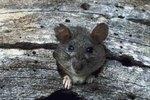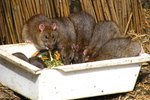
Though considered a pest species due to their tendency to congregate in large numbers and emit noxious odors, box elder bugs do not frequently sting people and are thought to be harmless. Due to their foul scent and potentially bitter taste, many animals dislike box elder bugs as a food source. Members of the ever-opportunistic rodent family are among the few natural predators of the box elder bug.
Box Elder Bugs
Box elder bugs, also called maple bugs, are members of taxonomic order Hempitera, which includes aquatic bugs, damsel bugs and assassin bugs. They are attracted to the female box elder tree and other members of the elder family, including maples. Box elder bugs are considered a nuisance due to their habit of congregating in large numbers, particularly on the sun-drenched south sides of buildings in the fall. Warm spells during the winter can tempt them indoors, where their excrement can stain upholstery and carpeting. Though they are an unpleasant presence in the home, the animals who prey upon them may be even less desirable.
Eastern Chipmunks
Although their diet consists of mostly fruits, nuts and seeds, chipmunk diets are supplemented with insects like the box elder bug. Their favorite foods are acorns and hickory nuts, according to the Lakeside Nature Center website. They may also feed on mushrooms or bird eggs. Chipmunks transport food in their cheeks to caches in burrows throughout their home ground, particularly in the autumn when preparing for winter. Chipmunks may prefer forests to the suburbs, but they can be found burrowing under stone walls and shrubs within the city.
Norway and Black Rats
Norway rats and black rats were inadvertently introduced to the Americas by travelers from Europe. Norway rats may also be called brown rats, house rats, barn rats, sewer rats, gray rats or wharf rats. Adults weigh an average of 1 pound. Black rats are slightly smaller, most members of the species are indeed black. Rats prefer fresh food including cereal grains, meats, fish, nuts and fruit. Though they are nocturnal, in larger populations they may be active in the day. Rats prefer fresh, unspoiled food supplies and a balanced diet; they will enthusiastically devour whatever foodstuffs may fit the bill, including hapless box elder bugs.
House Mice
Like their larger rat relatives, 1-ounce house mice are opportunistic feeders who enjoy all kinds of food found inside human habitats. While forest dwellers may forage for grain and seeds, they may also eat roots, leaves and stems. They'll eat insects when they're available. Mice within houses feast upon whatever they can, including bacon, butter and chocolate. The house mouse's role as predator of any resident box elder bugs will not be significant, according to a University of Michigan zoology website.
References
- United Exterminating Company: The Box Elder Bug Page
- University of Michigan Museum of Zoology: Boisea Trivittata Box Elder Bug
- Lakeside Nature Center: Eastern Chipmunk
- University of Michigan Museum of Zoology: Eastern Chipmunk
- Internet Center for Wildlife Damage Management: Norway Rats
- Critter Catchers Inc: Mice Control
- University of Michigan Museum of Zoology: House Mouse
- University of Michigan Museum of Zoology: Black Rat
Photo Credits
-
David De Lossy/Photodisc/Getty Images




